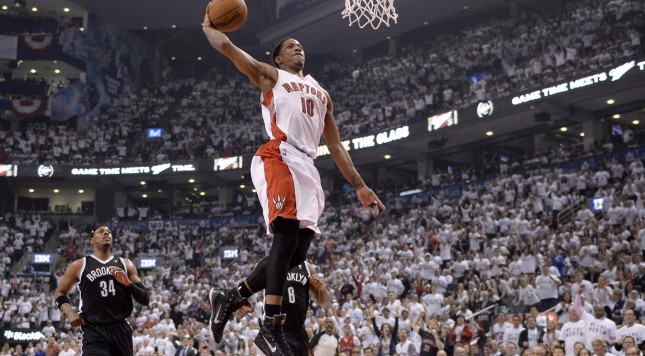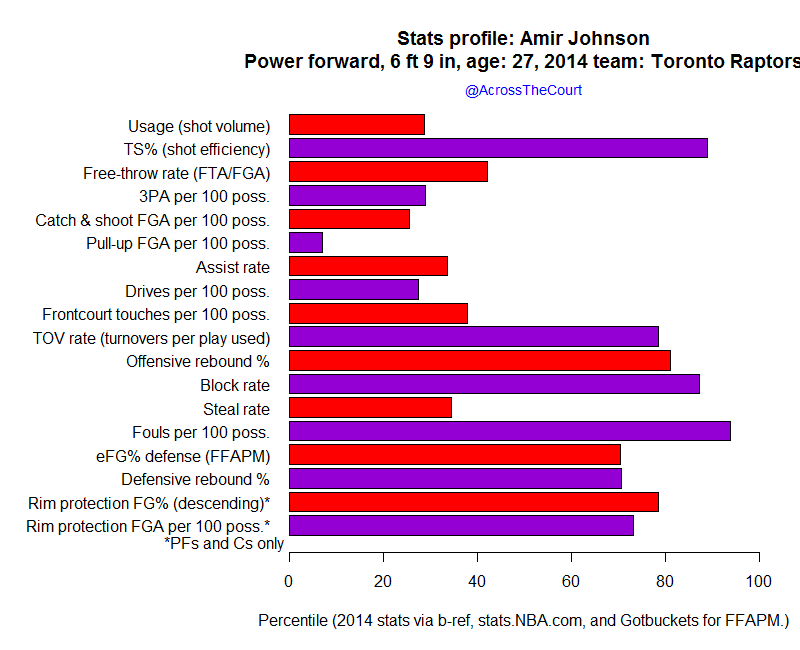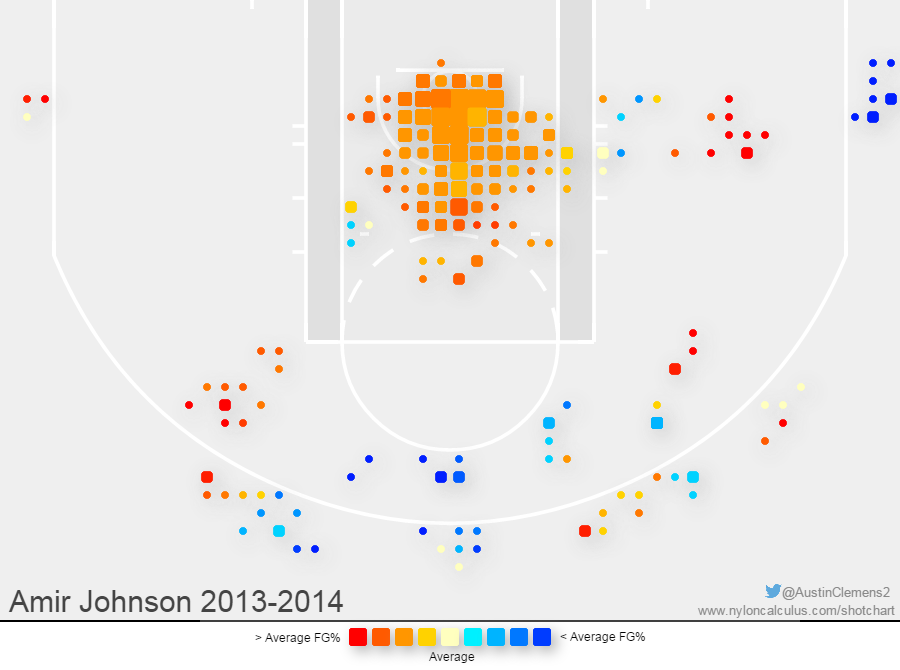Toronto set a franchise record in wins — one win better than what they had in the Vince Carter era and one win better than what they had in the Bosh era — and with steady, wise management from Ujiri the future is still bright. With the rewritten history books, Charlotte was given its Hornets history in the 90’s and New Orleans has its success with Chris Paul still. Toronto is the only franchise without a 50 win season, but they have a chance at breaking that threshold now.
2014 in review
After Rudy Gay infamously banned stat sheets from the locking room, like if Richard Nixon banned newspapers from the White House, there was a lot of debate about Rudy Gay and his value to the Toronto team. He was scoring roughly 20 points a game, and by conventional measures he was “the” guy for the team. So why wouldn’t his loss matter?
Rudy Gay became the metonymic standard for the fight between advanced stats and players, and the relationship of usage and efficiency. We could have named the usage-efficiency curve after him. He was using as many plays as guys like LeBron and Carmelo use, but he had the accuracy of a brick flung from a crumbling catapult. And what happened to his 19.2 points per game? His field goals and plays in general were redistributed to other players, and they more effectively used them. In the 18 games with Gay, they scored at a rate of 104.7 points per 100 possessions: below average. And after the trade, they scored at a scorching 111.0 points per 100 possessions, which was Miami Heat/Spurs-esque. The ball ran more through Lowry, a guy who could actually distribute, and he scored 5 points more, while DeRozan took the rest of the scoring load and made an all-star team. They lost a hard-fought 7 game series versus a weird Nets team in the first round, but they found their direction as a team.
Changes
Exit: John Salmons, Rudy Gay, Steve Novak, Nando De Colo, Dwight Buycks, Julyan Stone, D.J. Augustin, Quincy Acy, Austin Daye, Aaron Gray.
Enter: James Johnson, Louis Williams, Greg Stiemsma, Lucas Nogueira, Bruno Caboclo.
Toronto is losing a gaggle of small forwards. Gay was traded during the season, of course, but Salmons is gone and he played 1280 minutes last season and Novak, their sharpshooter, is off to Utah. Everyone else they lost had a place at the end of the bench. To replace them, they brought in the former Grizzly James Johnson and his black belt for his second stint with the Raptors. Lou Williams will be granted the role of sixth man scorer, and Stiemsma will fight for backup center minutes with rookie Lucas “Bebe” Nogueira. Bruno Caboclo is Toronto’s infamous first round pick, the one no one saw coming and someone who was unknown to everyone but the most informed international scout. Ten years ago, Toronto shocked everyone when they drafted epic draft bust Rafael Araujo — let’s hope history doesn’t repeat itself.
Player spotlight
Amir Johnson is arguably the current captain of the “no stats all-stars” as an honor that was previously given to Nick Collison, Jason Collins, and Shane Battier. Earlier in his career, he put up ferocious per minute stats, mainly rebounding, blocks, and steals, but as he’s aged and his stats have slipped his value has skyrocketed. By my measures, he’s clearly the second most valuable player on the team, ahead of real life all-star DeRozan and prized prospect Jonas Valanciunas. Looking at his stats below, this is surprising given his offense. He is an extremely efficient player, but he takes few shots and nothing stands out besides his offensive rebounding. He takes a low number of three’s and other jumpers, and his assist rate is pretty good for a power forward but not exceptional. He turns the ball over too much and doesn’t get to the line, so what is it?
Defensively, Johnson’s clearly valuable. He’s above average everyone but steals. His rim protection numbers and eFG% defense percentile indicate that he’s an above average defender at an important position. But again, nothing really stands out. Turning to more in-depth stats and while his individual rebounding numbers are nothing special for his position, his teams, adjusted for other factors, rebound at higher rates. Unlike a large portion of his rebounding cohorts at power forward, he does not “steal” rebounds from teammates. He stays on position, helps box out the opponent, and focuses on the team gaining the rebound, not for his own stats. This helps his low rebounding totals on defense reach more respectable levels. Then there are his screens, where he’s one of the best in the league. These do not show up in box scores like passes do with assists, but they help his team’s offense and it explains why his teams do so much better with him on offense despite the low scoring totals.
Amir Johnson is also a floor-spacer. He’s been taking long two-pointers at the top of the key for years, and he just added a three-point shot. This gives players like Jonas more room to work with inside and it puts pressure on a defense during high pick and rolls because they have to worry about his jump shot. Throughout his career he’s had little action on both baselines, but last season he experimented with a corner shot. But his real strength is finishing inside; he’s been one of the best there for a while. As a high school prospect, he was coveted for his athleticism and length. (Plus his listed height might be selling him short.) His physical skills translated into a top-notch finishing ability.
Against the hulking Washington frontline, Amir Johnson in the playlist below (link’s also here) still made a number of great plays. In the first video, he receives a lobbed pass from on an inbound play and drives to the basket with his defender behind him. Looking back at shot chart, you can see a dark orange and red area in the paint from 5 to 8 feet away. He uses a nice floater to hit the shot before Gortat has an opportunity to block him. In the second video you can see the value of his screens. His defender hangs back because the defense is worried about Lowry coming off the screen, so he jumps back behind the three-point line and hits a three. In the third, he begins to set a pick and then he dives to the rim for an easy lob. The fourth video has him finishing on a fast break with a windmill dunk that shows off his athleticism. Finally, the last video has him finishing with a dunk using his bread and butter: pick and roll.
For Amir Johnson’s defense, I have a playlist of his blocks (link’s also here) versus the Phoenix Suns. His first block occurs when he hangs back and protects the paint, and rejects PJ Tucker’s attempt at a dunk. In the second video, he stops high-flier Miles Plumlee from scoring off an offensive rebound. Also note how quickly he closes out on a shooter in the corner. The last video is a display of his speed and leaping ability as he blocks the most efficient shot in the game: the fast break inside shot.
Amir Johnson doesn’t stuff the box score in traditional ways. He’s a highly efficient scorer who spaces the floor and sets some of the best picks. He’s a very good interior defender who protects the restricted area and helps his team rebound. DeRozan has the points per game throne in Toronto and Jonas is the king of potential there, but Amir’s a large reason for their success last season.
2015 projected
Since the team will have its core players back, it’s correct to assume they’ll be largely the same. The most glaring issue is Kyle Lowry being able to play 79 games and 2862 minutes. He’s missed an average of 12 games in the past 5 seasons, prorating the lockout season to 82, and has only played more than 2100 minutes one another time. If they have a chance at 50 wins, he’ll need to stay upright and play heavy minutes.
Although the Raptors are still pretty young, the moves they made in the off-season don’t figure to help them much. Lou Williams rates at one of the worst major rotation players in the league thanks to indifferent defense and few positive dimensions. Yet he doesn’t even rate as a good scorer, which is his only strength. He has average efficiency and with some quickness gone he barely had an above average usage rate: he was a gunner who couldn’t even gun anymore. He’s sinking any gains they’ll make from youth and could take time from more promising players.
Divining an NBA season is basically impossible though. It’s not just about figuring out which players are important and how valuable they are; you still have to predict who will play and how injuries will change things. Toronto’s bench has an intriguing mess of useful players and guys who project as net negatives, like the aforementioned Williams and rookies like Caboclo. If they tailor the rotation to maximize the minutes they receive from their best players, they can improve by a sizable amount. Last year, for instance, John Salmons improbably filled out 1200 minutes. James Johnson, thanks to some impressive block and steal numbers, rates as a surprisingly good player, but I’m not sure if he’s actually that good and how much he’ll play.
Patrick Patterson played well for the Raptors after a trade brought him in, a stretch 4 with acceptable defense, but will he still receive a heavy portion of minutes at center or will they go with the less productive traditional center Greg Stiemsma? The latter’s a good shotblocker, but that’s his only talent, he hasn’t been guaranteed a roster spot yet though it’s likely, and Patterson could share minutes with Amir Johnson too since Amir can switch onto centers for him.
Another issue is the fact that Toronto doesn’t have its own D-league team, making it more difficult to develop Caboclo and Nogueira. Caboclo is like Giannis Antetokounmpo, all limbs and even rawer with a 7′ 7″ wingspan playing small forward, and the team can’t control his training with another D-league team. He’ll likely earn a lot of spare minutes on the Raptors. Nogueira is young and skinny too but a little more controlled having played in the ACB for a couple seasons. The Raptors love their potential and will keep them close to the team to track their development.
All eyes are set on another young duo, however. DeRozan is fresh off an all-star game since the coaches needed a representative from Toronto and its good record and coaches dislike Lowry, and while he’s more of an empty scorer — his best attribute is high scoring totals — he’s young enough that it’s possible to make large strides going forward. He has more defensive and playmaking nuances to pick up on, but at least he’s an ironman. He was one of three players to top 3000 minutes for the second year in a row and submitted a crazy 57 minute game back in the spring. For what it’s worth, he has a chance at holding the record for most 55+ minute games since 1986. (The real record, as many are, is probably held by Wilt Chamberlain.)
Valanciunas is one of those young guys people assume will be a star or at least a very good player down the road. He’s still young, sure, but he’s not there yet and expecting a high amount of production from him this season is too optimistic. Yearning for the bygone era where centers ruled the league, people still target big centers with post skills, but that’s not what’s winning the league anymore. Jonas has few guard-like skills with a tiny assist rate, few drives to the basket, and few jumpers. His defense overall isn’t good yet either, and going forward that’ll probably be the most valuable facet of his game, not his scoring. Of course, he’s still very young, but I’m just projecting this season.
Bringing this all back home, Lowry’s the key to their offense and their season. He’s a feisty defender too and brings a wide-range of skills to help the team. DeRozan had 4.8 more points per game, but he also needed 4.1 more field goals and 3.1 more free throws than Lowry in two more minutes of floor time. And they were somehow nearly tied in turnovers despite Lowry hands out almost twice as many assists while leading the offense. Toronto’s offense, meanwhile, ebbed and flowed in harmony with Lowry being on the court. Scoff at his plus/minus numbers, but my expanded box score ASPM liked him almost exactly the same. For a more approachable example with NBAWOWY, in 145 minutes when Lowry played without DeRozan, with Amir Johnson and Jonas set as constants, the team scored at a 112.7 points per 100 possession rate. Without Lowry and with DeRozan in the game, that dropped to 106.5 points in 92 minutes. As Lowry approaches 30, he’s running out of time to make the all-star game even in a diluted eastern conference. Now all we need to do is convince coaches.
Summary
Toronto’s a good mixture of youth and “young veterans” where some of their best players are in their late 20’s and they rely on no one in their 30’s, save for deep frontcourt reserve Chuck Hayes at 31. The team’s ceiling in the coming years will be defined by how their youngest guys develop and if they can gain a star or a secondary force from that collection. For now, they’ve got a good chance at leading the second-tier in the eastern conference below the Cavaliers and the Bulls if healthy and running on all cylinders. In the east, the third seed is a coveted position because you don’t have to face LeBron until the conference finals. There’s something to fight for here along with the distinguished 50 win mark, and for Toronto fans this could be their first golden age.
Wins: 49
Losses: 33
Conference rank: 3rd
League offense rank: 10th
League defense rank: 12th
Edited 10/27/14






















